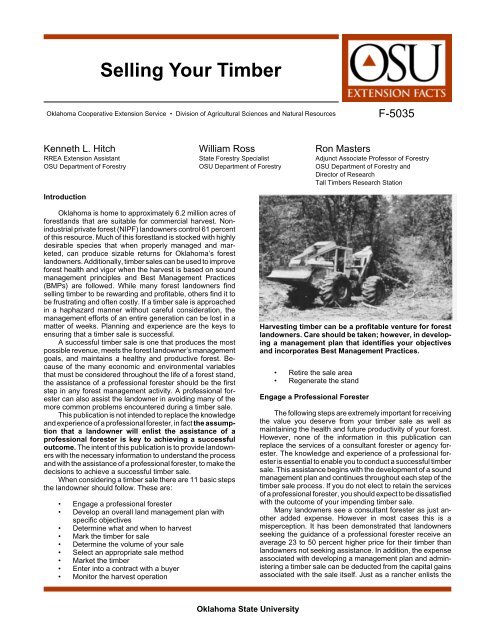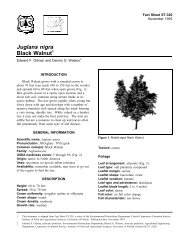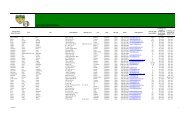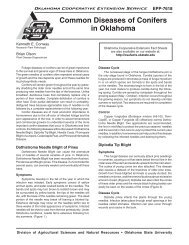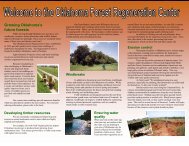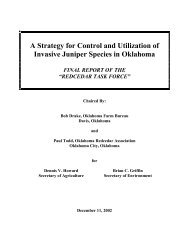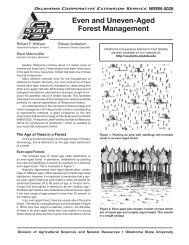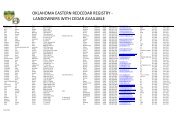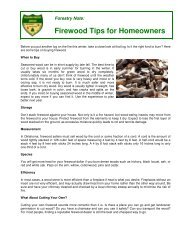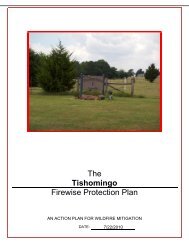Selling Your Timber - Oklahoma Forestry Services
Selling Your Timber - Oklahoma Forestry Services
Selling Your Timber - Oklahoma Forestry Services
Create successful ePaper yourself
Turn your PDF publications into a flip-book with our unique Google optimized e-Paper software.
<strong>Selling</strong> <strong>Your</strong> <strong>Timber</strong><strong>Oklahoma</strong> Cooperative Extension Service • Division of Agricultural Sciences and Natural ResourcesF-5035Kenneth L. Hitch William Ross Ron MastersRREA Extension Assistant State <strong>Forestry</strong> Specialist Adjunct Associate Professor of <strong>Forestry</strong>OSU Department of <strong>Forestry</strong> OSU Department of <strong>Forestry</strong> OSU Department of <strong>Forestry</strong> andDirector of ResearchTall <strong>Timber</strong>s Research StationIntroduction<strong>Oklahoma</strong> is home to approximately 6.2 million acres offorestlands that are suitable for commercial harvest. Nonindustrialprivate forest (NIPF) landowners control 61 percentof this resource. Much of this forestland is stocked with highlydesirable species that when properly managed and marketed,can produce sizable returns for <strong>Oklahoma</strong>’s forestlandowners. Additionally, timber sales can be used to improveforest health and vigor when the harvest is based on soundmanagement principles and Best Management Practices(BMPs) are followed. While many forest landowners findselling timber to be rewarding and profitable, others find it tobe frustrating and often costly. If a timber sale is approachedin a haphazard manner without careful consideration, themanagement efforts of an entire generation can be lost in amatter of weeks. Planning and experience are the keys toensuring that a timber sale is successful.A successful timber sale is one that produces the mostpossible revenue, meets the forest landowner’s managementgoals, and maintains a healthy and productive forest. Becauseof the many economic and environmental variablesthat must be considered throughout the life of a forest stand,the assistance of a professional forester should be the firststep in any forest management activity. A professional forestercan also assist the landowner in avoiding many of themore common problems encountered during a timber sale.This publication is not intended to replace the knowledgeand experience of a professional forester, in fact the assumptionthat a landowner will enlist the assistance of aprofessional forester is key to achieving a successfuloutcome. The intent of this publication is to provide landownerswith the necessary information to understand the processand with the assistance of a professional forester, to make thedecisions to achieve a successful timber sale.When considering a timber sale there are 11 basic stepsthe landowner should follow. These are:• Engage a professional forester• Develop an overall land management plan withspecific objectives• Determine what and when to harvest• Mark the timber for sale• Determine the volume of your sale• Select an appropriate sale method• Market the timber• Enter into a contract with a buyer• Monitor the harvest operationHarvesting timber can be a profitable venture for forestlandowners. Care should be taken; however, in developinga management plan that identifies your objectivesand incorporates Best Management Practices.• Retire the sale area• Regenerate the standEngage a Professional ForesterThe following steps are extremely important for receivingthe value you deserve from your timber sale as well asmaintaining the health and future productivity of your forest.However, none of the information in this publication canreplace the services of a consultant forester or agency forester.The knowledge and experience of a professional foresteris essential to enable you to conduct a successful timbersale. This assistance begins with the development of a soundmanagement plan and continues throughout each step of thetimber sale process. If you do not elect to retain the servicesof a professional forester, you should expect to be dissatisfiedwith the outcome of your impending timber sale.Many landowners see a consultant forester as just anotheradded expense. However in most cases this is amisperception. It has been demonstrated that landownersseeking the guidance of a professional forester receive anaverage 23 to 50 percent higher price for their timber thanlandowners not seeking assistance. In addition, the expenseassociated with developing a management plan and administeringa timber sale can be deducted from the capital gainsassociated with the sale itself. Just as a rancher enlists the5035 / 1<strong>Oklahoma</strong> State University
services of a veterinarian, or a farmer seeks the assistance ofan accountant for tax purposes, the forest owner should seekthe advice of a professional forester when developing a timbermanagement plan. Free forestry assistance in many aspectsof forest management is also available through many state,federal, and private organizations. A list of these sources isincluded at the end of this publication. It is important to realizehowever that these agencies will not typically provide assistanceduring the sale administration phase of the timber saleprocess. A consulting forester will need to be retained toadminister the actual sale.Develop an Overall Land Management Plan with SpecificObjectivesAs with any business venture, the first and most importantstep is to develop and follow a written management plan.Careful thought and consideration should be given to identifyingunique ownership objectives, or why you have chosen toown land as opposed to other uses for your capital. In mostcases there will be multiple objectives that may, or may not,compliment one another.Objectives do not necessarily determine specific managementactivities instead they identify ownership goals,which the specific management activities will attempt toachieve. For example one objective might be to increase thegrowth on suitable acres. Management strategies to achievethis goal might include intensive plantation management and/or management of the existing natural stands. Another objectivemight be to improve habitat for a specific wildlife species.Here possible management activities could include prescribedburning and/or some form of timber harvest. Of course, therecould also be a host of other management activities, whichcould improve wildlife habitat depending on stand conditionsand the wildlife species of interest.A sound management plan will consider specific ownershipobjectives as well as the potential of the forest to meetthose objectives. A good forest management plan will thenoutline the actions that are needed to achieve the objectivesas well as the timing of those activities. The plan should alsoallow enough flexibility to adapt to changing market andresource conditions. Any harvest activity should be a part ofthe developed management plan, undertaken with the goal ofattaining specific stated objectives. As with other types ofbusiness, unplanned or forced sales are rarely best for eitherthe seller or the resource.When developing a management plan, remember thatBMPs are designed to protect the environment and thereforethe investment in the future of the timber stand. The forestindustry and landowners throughout <strong>Oklahoma</strong> have adoptedthese guidelines to protect sensitive riparian areas, soil productivity,and water quality. While the practices are currentlyvoluntary, their adoption will help to insure that more restrictivemandatory actions are not required at some point in thefuture. Even if the goal is land conversion, it is important toexplore the alternatives. In some cases soil limitations, advantagesof diversification, recreational use opportunities,and land value concerns will encourage the regeneration offorestlands.of dead or dying timber, or conversion to other land uses. Mostoften the harvest is done to reach long term objectives asdefined by the forest management plan. These activitiescould include thinnings, regeneration cuts, timber stand improvements,and final harvests.There are many different harvest methods. Each of thesemethods is suited for a particular site and objective.Salvage cuts remove damaged, dead, and dyingtimber. These types of cuts are used in cases of ice,wind, water, fire, and insect damage. They can alsobe used when timber must be cleared for the constructionof roads and right-of-ways. If they need tobe cleared using a bulldozer the timber may still besalvaged, however, higher stumps may need to beleft in order to remove roots.Thinnings are used to open up the stand to allowoptimal growth of remaining trees, or for enhancementof wildlife habitat. The thinning may beprecommercial (trees have not yet reached a merchantablesize) or commercial. In either case extremecare should be taken to protect the remainingtrees.Uneven-aged regeneration cuts (selection andgroup selection) are used to remove mature andundesirable trees from a stand while providing growingspace for future regeneration. The selection oftrees to remove can have a dramatic impact on thevalue of the sale as well as productivity of theremaining stand. The practice of removing all treeslarger than a certain diameter should generally beavoided. The trees to be removed should be markedindividually at breast height (4.5 feet) and on thestump. Typically trees are all marked on the sameside, i.e. the north side, towards the road, or on theuphill side. This will make it easier for the loggingcrew to locate trees slated for removal. A professionalforester can provide valuable assistance in aselection harvest. Caution must be observed toprevent damage to the residual stand during thelogging operation.Determine What and When to HarvestThe next step in conducting a successful timber sale is todecide why you are harvesting timber and what type ofharvest will best achieve established goals. The type ofharvest should always be tailored to meet the landowner’sobjectives for selling timber. The harvest may be designed toreach a short-term goal, such as emergency capital, salvageIntermediate cuttings, such as this thinning of an oakforest, can allow a landowner to improve a stand of trees,while realizing income from selling commercial productssuch as firewood or pulpwood. Reforestation plans shouldbe made prior to harvesting timber.5035 / 2
Even-aged regeneration cuts (shelterwood andseed tree) are typically done to begin the regenerationof a mature stand. This harvest method is oftenassociated with shade intolerant species. Selectmature trees are left to provide seed source for thenew stand. The seed trees should be of seed producingage with desirable characteristics for the newstand. A professional forester can assist in theselection of seed trees, as the spacing requirementsare different for each species and site. Typically thetrees to be left as seed source are conspicuouslymarked with paint at breast height and at the stumplevel. After regeneration is complete and a stand iswell established, the seed trees may also be removedduring a later harvest or thinning of the new stand.Clearcuts are used to remove all merchantabletimber from a stand. This harvest method is suited tosituations when species conversion, land conversion,or artificial regeneration by planting is desired.The area is marked off using paint or flagging, withsensitive areas such as those set aside due toerosion, wildlife, unique features, or aesthetic concernsbeing clearly designated. An important point toremember is that not all trees are removed. Onlythose that are merchantable are taken. Trees thatare unmerchantable due to size, quality, or speciesremain. It is important to note that without further sitepreparation and planting the stand could regenerateinto a forest composed of undesirable unmerchantabletrees.Mark the <strong>Timber</strong> for SaleOnce a harvest method is selected, the trees to be cutmust be clearly identified. In a clearcut this is relativelystraightforward. The area to be cut must be clearly markedand distinguished from residual or no cut areas. With otherharvest methods the selection of individual trees can have adramatic effect on the value of the sale as well as the conditionand productivity of the remaining stand. If the better trees areselected for sale and the remaining trees are of inferior qualityor undesirable species, forest health and future productivitywill decline. However if the sale trees are all of low quality,poor form, and undesirable species, you may not attract aninterested buyer. An experienced professional forester candetermine the optimal mix of desirable and undesirable trees,which will yield the highest sale price while maintaining futureproductivity and achieving the stated management objectives.The <strong>Oklahoma</strong> <strong>Forestry</strong> Code requires timber ownersauthorizing a timber harvest to clearly mark establishedproperty lines, which are within 100 feet of the area to be cut.If property lines can not be located the seller must notify alllandowners adjoining the sale area by certified mail at least 10days prior to the harvest operation. If the mailing address isnot known for adjoining landowners the seller must publishnotice in the local newspaper at least 10 days prior to the sale.Under <strong>Oklahoma</strong>’s <strong>Timber</strong> Theft Law timber owners are liablefor damages, which occur on adjoining property if the boundariesare not marked, marked improperly, or if the sellernegligently directs logging onto lands of another without priorconsent.Even if the harvest will be more than 100 feet distant fromadjoining landowners, the boundaries of the sale area, specialareas that are not to be harvested, and streamside managementzones should be clearly marked.Determine the Volume of the SaleAfter the trees to be cut are selected and identified, it isnecessary to determine the volume that will be harvested.Without this knowledge it is impossible to determine the fairmarket value of the timber. A professional forester can assistin developing an inventory of the harvest area. This inventoryshould include the volume of all trees in the harvest unit byspecies, grade, and product class. This segregation is importantbecause the prices received for these various productsand grades are significantly different. Once the species,grade, and product class information is developed, the valueof the sale can be determined.Some values can be difficult to establish since someproducts have no fair market to monitor. Aesthetic beauty,recreational opportunities, and social benefits are all subjectivevalues that must be determined by the landowner. Thesevalues can dramatically affect the resale value of land andshould be considered. However, in this discussion, we willconcentrate on the value of timber as a market commodity.Knowledgeable and informed parties freely trading in anopen market with many buyers and sellers set the fair marketvalue of timber. If there are a limited number of buyers orsellers in the area, the prices paid may not reflect the marketprice in other areas. It is a relatively easy matter to find theprice of delivered logs by calling concentration yards andsawmills in your area. A list of those facilities can be obtainedby calling the <strong>Oklahoma</strong> Department of Agriculture <strong>Forestry</strong><strong>Services</strong> or the OSU Cooperative Extension Service ForestUtilization and Marketing Specialist listed at the back of thispublication.Unfortunately, determining fair market prices for stumpage(standing timber or downed timber, which has not yetbeen cut into logs) is much more difficult. The expectedstumpage price can be estimated using the following formula:Stumpage Price = Delivered Price - (Logging andTransportation Costs + Loggers Profit)The determination of logging and transportation costscan be complicated. However, a professional forester canmake a reasonable estimate using the following factors.Volume of the sale will have a dramatic effect onstumpage prices. Certain fixed costs are associatedwith the startup of a harvest operation, which mustbe recovered. Larger sales allow the fixed costs tobe spread over more units than small volume sales.If all else is equal, large volume sales will yield higherstumpage prices than small volume sales.Quality of the timber in the sale will also affect thestumpage price. High quality logs, desirable species,and high value product classes will receivehigher prices at the mill and therefore have higherstumpage values. Also high quality products tend tobe in short supply and receive more interestedbidders, which can raise prices. Low quality productsmay receive few interested bidders, which mayresult in a lower offered price.Size of individual trees within the sale will affectstumpage prices in two ways. First, as previouslydescribed larger trees may have higher quality products.Second, larger trees may have lower handlingcosts because the logger will have to handle fewertrees to harvest the same volume. There is a pointwhen trees become so large that they are too difficult5035 / 3
to move. Many modern mills are also geared towardssmaller diameter logs and may not be able toefficiently process logs over 36 inches in diameter.Trees that are too small or large to be efficientlyprocessed into salable products will receive lowerprices than trees of optimal processing size.Distance to markets will affect offered price due tothe expenses associated with hauling logs from thestump to the processing facility. The logger mustpass operating costs including fuel, tools, time, andequipment wear to the landowner. As haul distancesincrease stumpage prices can be expected to decrease.Presence and condition of access roads willaffect the price of stumpage on individual tracts.Haul roads are expensive to construct and maintain.In many instances the construction of these roadswill add significant value to the residual stand andproperty. This increase in property and timber valueshould be considered if roads will be constructed orimproved by the timber buyer. Roads, which arealready present, increase the value of stumpage ifthey are in usable condition for large trucks, and areproperly located for efficient removal of the timber.Tracts that are located close to all weather roads willgenerally receive higher prices than tracts that aremore remotely located.Logging difficulty and conditions also influencestumpage prices on individual tracts. <strong>Timber</strong> soldfrom with excessive slopes, rocky or highly erodablesoils, and limitations due to drainage or floodingreceive lower prices than that from areas withoutthese restrictions. Tracts that can be logged duringwet periods should receive higher prices, since theycan be logged when timber may be in short supply.Restrictions placed on the logger by the seller, suchas limited access points, maintenance of roads,hours of operation, and duration of the harvestactivities, may also reduce the price paid for stumpage.Market conditions or the supply and demand fortimber in your area will affect the price paid forstumpage at a given point in time. Log prices, andtherefore stumpage prices, fluctuate on a daily basis.<strong>Timber</strong>, unlike grains and many other farmcommodities, can be stored for extended periodsassuming that it has not been damaged by insects,ice, wind, or other agents. If the market is soft andthere is no dire need for capital, a landowner caneasily wait a few months, or even a few years, for themarket to again rise.Select an Appropriate Sale MethodOnce a value has been placed on the timber to be sold,the appropriate sale method must be determined. Manyfactors affect this decision and the choice can have seriouseffects on your tax situation, the price received, and theperceived value of the sale proceeds. An accountant or taxadviser should be consulted before selling timber to assurereaching the desired outcome from any sale.Sale-by-unit, pay-as-cut, or sale-by-scale salesare those sales in which a price per unit is agreedupon and the landowner is paid for those unitsremoved from his land. Payments are generallymade on a periodic basis and a third party is responsiblefor determining the amount of material removed.It is important that the landowner havecomplete trust in the logger and the monitoring partyto prevent disputes over the number of units removed.There are several ways to record thoseunits, whether they are scaled at the landing, on thetruck, or at the point of delivery. In any case, it isimperative that the landowner be available to monitorthe removal of timber or have a great deal of trustin the buyer.It is also important that the utilization standardsare agreed to and included in the contract, particularlyif more than one product class (i.e. sawtimber,pulpwood, and utility poles) is being sold. Withoutmerchantability standards, there is nothing to preventthe logger from removing only the highestquality materials and leaving lower quality materialson site or paying pulpwood prices for small sawlogs.Because the units removed must be tallied, this typeof sale is the most difficult to administer, but mayhave tax advantages due to the fact that possessionis retained until the timber is actually cut. In thisinstance, the timber may be classified as a specialtype of business property and may be treated ascapital gains. Because possession is maintaineduntil the timber is cut, the landowner retains the riskassociated with damage during the interval betweencontract execution and harvest.Lump-sum-sales are the sales where a sum ofmoney is paid, generally at the start of the harvestoperation or on an approved payment schedule, forall timber included in the sale. This type of sale is theeasiest to administer because there is no recordingof the units removed. Also the seller knows ahead oftime what amount will be received for the sale.Assuming sales are infrequent, and the timber hasbeen owned more than the required holding periodof 1 year, the proceeds from lump-sum-sales qualifyas a long-term capital gain. The buyer assumes therisk associated with damage during the intervalbetween contract execution and cutting. Large tractswith high values may yield lower prices in a lumpsum sale due to the amount of capital required.However this problem can be avoided by establishinga payment schedule in which portions of the saleprice are due as the timber is removed.Market the <strong>Timber</strong>Selecting the appropriate type of sale is a key element tohaving a successful timber sale. To receive the highestpossible prices, the forest landowner must do more thanmerely sell their timber. They must actively market theirproduct. <strong>Timber</strong> is typically sold by forest landowners in oneof three ways.Single offer sales occur when an interested partyapproaches a private landowner. The landownerthen makes the decision to sell or not sell their timberbased on this single offer. A great deal of timber fromprivate non-industrial forestlands is sold in this way,often without any sort of management plan or considerationof the owner’s management objectives. Inorder to receive the maximum value for your timber,5035 / 4
timber buyers as do most consultants, sawmills, andconcentration yards.Advertisements for your sale should be sent to eachbuyer on the list. The advertisement should include thefollowing elements.These logs were sold as pulpwood by a landowner to atimber buyer, but there are several sawlogs within thispile of timber. Greater income from the sale could havebeen realized if an accurate inventory was made of theforest land before the sale occurred.you must market your timber not just sell it. Theforest landowner will not receive top dollar for theirtimber if this type of sale is implemented.Negotiated bid sales are those in which the timberowner enters into oral negotiations with severalinterested parties. <strong>Timber</strong> brokers often use thistype of sale when high value timber is being sold.Most landowners lack the knowledge and experienceto negotiate an optimal sale price. This type ofsale may be appropriate if markets are weak, if youwish to work with a particular buyer, or if you aremarketing specialty products such as poles or highvalue hardwoods.Sealed bid sales will most often reap the highestreturns for the private non-industrial forest owner.When selling timber, it is important to remember notto jump into anything too quickly. The timber ownershould work to receive as many bids as possible forthe sale. It is not uncommon for the bid prices to varywidely; in fact the highest bid will often be twice thatof the lowest bid. In some instances there may beonly one or a few buyers interested in the sale. Inother cases many bidders may be interested. Theforest owner can obtain lists of potential timberbuyers in the area from several sources. The OSUUtilization and Marketing Specialist keeps a list of1. Name and address of the seller or the forester managingthe sale.2. Location of the sale. In most cases a legal description ofthe property as well as a vicinity map showing nearbyhighways, towns, access points, and existing roads shouldbe included.3. Description of the trees to be sold. This descriptionshould include the inventory by species, size, andproduct class. A description of the sale area boundariesshould also be included. For some harvest methods, astatement defining how cut or leave trees are marked isalso necessary.4. Inspection period. All interested buyers will want to lookover the sale area. A time period (usually 4-6 weeks)should be designated for inspection of the sale area.5. Type of sale. Whether a lump sum or sale-by unit. Alsothe payment method (bank or cashiers check), paymentschedule, and whether or not a deposit must accompanythe bid.6. A statement that the seller reserves the right to refuse anyand all bids.7. Any major conditions or limitations on the sale. This is theplace to let the buyers know if they will be restricted in thetimes they can harvest, limits on access, erosion control,slash disposal, damages to residual stand, environmentallysensitive areas, etc. Keep restrictions reasonable, asthey generally add to the cost of logging. Excessive orunreasonable restrictions will make the job less attractiveto buyers, and will result in fewer interested buyers andlower bids.8. Whether or not a performance bond is required. Thiscould depend on the logger’s reputation, or lack ofreputation in the case of new companies. Generally, theperformance bond is $500-$2,500 and is held in escrowuntil the harvest operation is complete to ensure that allpoints of the contract are met.After a sale advertisement is developed it should be sentto all timber buyers in the area. You may also wish to publishthe advertisement in the local or regional newspaper.When the bid deadline arrives open the bids and selecta buyer. Some buyers may wish to be present when bids areopened. There should be no negotiations before or after thebids are opened. The highest bid may not be the best choicein all cases. The seller should consider the reputation of thebidder when making their selection. If no bids are acceptable,the seller may refuse all bids.Enter Into a Contract with a Buyer<strong>Timber</strong> sales, like any other transaction involving propertyand large sums of money, should be bound by a writtencontract. This will protect both the buyer and seller. Thecontract does not need to be complicated, however, it shoulddetail exactly what the buyer and seller have agreed to relativeto all aspects of the sale. The selected timber buyer will mostlikely have a standard contract. There is nothing wrong withusing an existing contract as long as it is considered as astarting point. Each landowner’s objectives are different, theirtimber stands are unique, and therefore their sales will bedifferent. No contract is perfect in all situations. Although5035 / 5
contracts differ from sale to sale there are certain provisionsthat should be included in any contract.The following information is not intended as legal advicenor is the sample contract provided in Figure 1 (on page 8) alegal document. They are included for your information and asan example. As with any legal matter, an attorney should beconsulted for legal advice and to review each contract beforesigning.1. The names and addresses of both the buyer and seller.This will identify the parties entering into the contract andshould be included in any legal document.2. Date of the contract’s execution.3. A legal description of the location of the timber sale alongwith a map of the sale area.4. A description of exactly what is being sold. If the sale isa clear-cut, a statement indicating all merchantable treeswithin the specified boundary may be sufficient. Ifindividual trees are to be removed from a stand thereshould be a statement describing exactly how those treesare marked.5. A declaration of the seller’s ownership and right to conveythe timber to the buyer.6. The selling price and how payment will be made. If this isa lump sum sale, the total selling price along with apayment schedule should be included. If the sale is asale-by-unit, the exact price per unit, method and locationof scaling, person responsible for scaling, and paymentplan should be included.7. The duration of the contract, and any extensions alongwith the cost of extensions. Typically a sale contract is setfor a period of 1 to 3 years. If the buyer has not removedall the timber in a specified time, the remaining timbershould revert to the original owner. Sometimesextensions are allowed with a payment equal to somepercentage of the original contract price.8. Provisions for assignment of all or part of the contract. Inmany cases there will be several product classes as wellas tops and stumps. The ownership of these productsand that owner’s ability to transfer those products to athird party, for example tops for firewood, should beclearly stated.9. Provisions for arbitration. This is included to settledisputes, which may arise after the harvest begins. Thissection should state clearly who will sit on thearbitration board, along with deadlines for judgment bythe board.10. Utilization standards should be clearly stated in cases ofa sale-by-unit sale. This is generally not required in alump sum sale as the buyer has already purchased theentire product. However, you may wish to add a clauserequiring that undesirable species or unmerchantabletrees be felled to facilitate site preparation. Utilizationstandards would include species, top limits, stump heights,etc.11. A statement indicating who is responsible should thetimber be destroyed or stolen after the contract is signed.Generally timber sold as a lump sum sale becomes theproperty and responsibility of the buyer when the contractis signed, while the seller retains ownership until thetimber is cut in a sale-by-unit sale.12. A statement of the legal and financial responsibilities ofthe buyer. This should include proof of adequate liabilityinsurance, worker’s compensation insurance, whether ornot a performance bond is required, and any practicesthe buyer must perform to control erosion. In addition,there should be statements of the buyer’s responsibilityfor damage to the seller’s property. This would includeroads, fences, crops, culverts, residual timber, etc. Ratherthan vague generalities, these statements should beclear and enforceable.13. Other restrictions such as points of access; constructionstandards; location of roads, skid trails, and landings;cleanup of trash and debris; times or periods whenoperation cannot continue; etc. should be included. Youmay also wish to ask for a harvest plan. This documentwill detail the location of landings, skid trails, and haulroads. There should also be provisions for sensitive areas.14. Finally, the signature of both parties along with witnessesin the presence of a notary public. The contract should thenbe filed with the county recorder in the county of the sale.Monitor the Harvest OperationBefore the harvest begins the seller should schedule ameeting with the logging contractor to discuss the particularsof the harvest operation such as the number and location oflandings, skid trails, and haul roads; any sensitive areas; andstreamside management zones. A harvest plan will include allof these details, and if it was specified that one would bedeveloped in the contract, now is the time to review it. Makecertain that the contractor knows where the harvest boundariesare and what practices are acceptable under the contract.This meeting should include a visit to the harvest sitewhere there can be no misunderstanding of the locations ofthe discussed areas and property boundaries.When the harvest operation begins the seller or hisrepresentative should be on hand to discuss any furtherconcerns that may arise during the initial startup of theharvest. As the harvest continues, the seller should continueto monitor the harvest and discuss any problems with thebuyer. Should a serious concern arise, which cannot beworked out, the matter should be turned over to the arbitrationboard designated in the contract.Retire the Sale AreaOnce harvesting has been completed, the harvestedarea should be inspected to make sure all contractual obligationshave been met and that all equipment has been removedfrom the site. Streams should be free of logging debris andtemporary crossing should be removed. Landings, skid trails,and temporary roads should be seeded to ground cover toprevent erosion, and water bars should be constructed whereneeded. All logging equipment and refuse associated with themaintenance and operation of such equipment should beremoved from the property. If everything is in order, a letterreleasing the buyer from the contract should be written, andany performance bond returned.Regenerate the StandPlanning the new forest should be done well before anyharvesting activity begins. This is true regardless of the typeof harvest or regeneration method. Harvesting, in addition toremoving trees, disturbs the soil to some degree and exposesit to sunlight. The area may quickly be overrun with weeds andsprouts of low-value tree species if site preparation andregeneration activities are not accomplished immediately.This will result in much greater than necessary expense inmeeting your goals. Consulting foresters are a very importantresource for stand regeneration. They will know the specificrequirement of the species to favor in the next forest as wellas the best methods for establishing the new stand.5035 / 6
SummaryThe harvest of a forest stand represents the culminationof years of management and more importantly the birth of anew forest. The actions you take now will affect the value andhealth of the forest for years to come. Any harvest should bea step in reaching the goals set forth in the forest managementplan. It is important to enlist the help of professionals whendeciding to sell timber. The assistance will help to ensure thatthe sale will move along smoothly while allowing the landownerto reach current objectives. Do not jump on the firstoffer received. <strong>Timber</strong> unlike most other farm commoditiescan be stored for extended periods, so take time and marketthe timber. Consider management goals when deciding whattype of harvest to conduct. Remember that the harvestoperations will have a profound impact on the site preparationand regeneration needs of future stands. Consider financialneeds and consult a tax attorney before selecting a type ofsale method. Always solicit as many bids as possible andnever enter a timber sale without a written contract, which hasbeen reviewed by an attorney. Always protect environmentallysensitive areas to protect the resource for future generations.Finally, monitor the harvest to ensure that the intent ofthe contract is being fulfilled. By following these guidelinesand enlisting the help of professionals, forest landowners willbe well on their way to successful timber sales.Where to get AssistanceThere are several sources of management assistanceavailable to forest landowners in <strong>Oklahoma</strong>. Many of theseservices are provided at no cost. Management assistance canbe obtained from the following sources:• <strong>Oklahoma</strong> Department of Agriculture - <strong>Forestry</strong><strong>Services</strong>(405) 522-6158http://www.oda.state.ok.us/frt.htmODA - <strong>Forestry</strong> <strong>Services</strong> offers free managementassistance for landowners that own less than 500 acres offorestland. They can assist in developing a management planand timber inventory. They administer the Stewardship IncentiveProgram as well as the Forest Stewardship Program,which are cost share programs for forest landowners, whowish to practice sustainable forestry on their lands. They alsomaintain a list of consulting foresters, timber buyers, andsawmills that operate within the state.• OSU Cooperative Extension(405) 744-6432http://agweb/okstate.edu/fwa/OSU Cooperative extension county agents canassist forest landowners with management decisions,educational programs and brochures. State ExtensionSpecialists can assist landowners in identifying managementoptions as well as identifying and integratingmanagement objectives. The OSU Forest Utilization andMarketing Specialist can also assist in the location ofsawmills and forest industry throughout the state.• <strong>Oklahoma</strong> Department of Wildlife Conservation(405) 521-4631http://www.wildlifedepartment.com/The ODWC administers the Wildlife HabitatImprovement Program, which is a state cost shareprogram for forest landowners.• <strong>Oklahoma</strong> <strong>Forestry</strong> Association(580) 286-3970http://www.okforestry.orgThe OFA administers the Tree Farm Program, whichis a national program consisting of professional foresters,who donate their time to assist private landowners. TheOFA also maintains a list of consulting foresters, timberbuyers, and certified master loggers on their web site.• <strong>Oklahoma</strong> Woodland Owners Association(918) 569-4287An association of private woodland owners devotedto private property rights, landowner education, andBMPs. Many OWOA members have sold timber on theirown property, and can provide much helpful advice.Other <strong>Forestry</strong> Extension Fact Sheets for Forest LandownersThese publications and many more are available from yourcounty extension office or via the Internet at http://agweb.okstate.edu/fwa/pubpage.html.F-5015 Farm Woodland ImprovementF-5021 Measuring Woodland <strong>Timber</strong>F-5022 Frequently Used <strong>Forestry</strong> Terms and NaturalResource Terms for Landowners in <strong>Oklahoma</strong>F-5028 Even and Uneven Aged Forest ManagementF-5030 Tree Improvement in <strong>Oklahoma</strong> WoodlandsF-5032 Lease Hunting Opportunities for <strong>Oklahoma</strong>LandownersF-5034 Riparian Forest BuffersL-267 Forest Stewardship Wildlife Management Note #1:White-Tailed DeerL-268 Forest Stewardship Wildlife Management Note #2:Bob-White QuailL-273 Forest Stewardship Wildlife Management Note #3:Wild TurkeysL-270 Forest Stewardship Wildlife Management Note #4:Snags, Cavity Trees, and Downed LogsL-271 Forest Stewardship Wildlife Management Note #5:Gray and Fox SquirrelsL-272 Forest Stewardship Wildlife Management Note #6:Cottontail RabbitsL-269 Forest Stewardship Wildlife Management Note #7:Wood DucksL-274 Forest Stewardship Wildlife Management Note #8:SongbirdsL-275 Forest Stewardship Wildlife Management Note #9:Mourning DovesL-276 Forest Stewardship Wildlife Management Note #10:Edge and Other Wildlife Concepts• Natural Resources Conservation Service(918) 423-8730The NRCS administers the Forest IncentivesProgram, which is a federally funded cost share programfor forest landowners. A conservation plan for forestedproperty can also be developed with their assistance.5035 / 7
Figure 1. Sample <strong>Timber</strong> Sale Contract.(Sale of Stumpage and No Other Relationship)WHEREAS, the undersigned , hereinafter referred to as “Purchaser” is prepared to purchase timber from ,hereinafter “Seller”; andWHEREAS,is prepared to sell timber under the terms and conditions hereunder; andWHEREAS, Seller and Purchaser mutually agree that activities performed by the undersigned under this timber sale contract shall be performedas a Purchaser and not as and employee; andWHEREAS, the parties desire to set forth their relationship in writing so that there may be no misunderstanding as to the relationship andresponsibilities;NOW THEREFORE, the parties do agree as follows:Because the Purchaser is to purchase timber, the parties agree to complete Addendum I. They further agree that Addendum I is a part of thisAgreement in all respects.1. The terms of this Agreement shall be applicable to situations involving the purchase of timber.2. The undersigned Purchaser shall purchase and the Seller shall sell the <strong>Timber</strong> specified in Addendum II.3. The undersigned Purchaser agrees that it is acting solely in the capacity of an independent party in carrying out the terms ofthis timber sale contract. It is agreed and acknowledged by the parties that the purchaser is not an employee, partner, associate,agent, or joint venture in any of the functions that it performs for the seller. The Purchaser has a separate place of businessat .4. The undersigned Purchaser agrees that it will save and hold harmless the Seller from any and all claims, penalties, or expensesof and nature, type, or description whatsoever, including reasonable attorney’s fees, whether asserted by an individual,organization, or governmental agency or subdivision connected or in any way related with the purchase and harvest of timberby the Purchaser. In furtherance of this clause, Purchaser shall carry Public Liability insurance in the amount of $_________and property damage insurance in the amount of $. Purchaser will be responsible for the same insurancerequirements on the part of any of its subcontractors.5. The Purchaser agrees that it will remunerate the undersigned Seller for its purchase of timber according to the terms andschedule of payment attached hereto and made a part hereof.6. The Seller agrees that the undersigned Purchaser shall have the sole control of the method, hours worked, time, and mannerof any timber cutting to be performed hereunder. The Seller reserves the right only to inspect the job site for the sole purposeof ensuring that the cutting is progressing in compliance with the cutting practices established hereunder. The Seller takes noresponsibility for supervision or direction of the performance of any of the harvesting to be performed by the undersignedPurchaser or of its employees or subcontractors. The Seller further agrees that it will exercise no control over the selectionand dismissal of the Purchaser’s employees.7. The Seller agrees that it will initially designate the timber to be sold and will also make a final inspection for purposes ofascertaining whether the timber has been cut in compliance with the specifications set out in Addendum I. All work will beperformed in a workmanlike manner. Work shall be performed in accordance with the requirements of the landowner. Thetimber that is to be cut along with the legal descriptions of the property are set out in Addendum II. The parties stipulate thatin fulfillment of the terms of this timber sale contract the Seller has clear and unencumbered title to the stumpage as the subject of thiscontract.8. The undersigned Purchaser agrees that it will furnish all materials, labor, equipment, tools, and other items necessary for theperformance of the contractual undertaking that it has assumed herein.9. The Purchaser shall be responsible for the filing of its own information returns and income tax forms.10. The Purchaser shall not assign or sublet this Agreement without the prior written consent of the Seller.11. The Purchaser has inspected the premises and knows and accepts it as being satisfactory to perform the Contract without riskto person or property.12. This Contract constitutes the full and final agreement and understanding between the parties and is a complete statement ofthe intended terms. This Contract shall not be modified except in writing signed by both of the parties hereunder.The time period for this Agreement shall begin on , 20 , and shall continue until the termination dateof , 20 , unless earlier termination is requested by either party by days written notice to the other.IN WITNESS WHEREOF, the parties have set their hands this day of , 20 .We have read and understood this Agreement and have received a copy of this Agreement. We understand that the Purchaser and its operationis NOT and will NOT be covered with Worker’s Compensation insurance supplied by the Seller.Approved and agreed to by Purchaser:WitnessByItsApproved and agreed to by Seller:WitnessByItsSCHEDULE OF PAYMENTThe purchaser and the Seller hereby agree to the following schedule of payment:Purchaser shall pay to Seller ($ ) per mutually agreed scale for the following species.OSU Extension Facts are also available on the World Wide Web at: http://agweb.okstate.edu/pearl/<strong>Oklahoma</strong> State University, in compliance with Title VI and VII of the Civil Rights Act of 1964, Executive Order 11246 as amended, Title IX of the Education Amendments of 1972, Americans withDisabilities Act of 1990, and other federal laws and regulations, does not discriminate on the basis of race, color, national origin, sex, age, religion, disability, or status as a veteran in any of itspolicies, practices or procedures. This includes but is not limited to admissions, employment, financial aid, and educational services.Issued in furtherance of Cooperative Extension work, acts of May 8 and June 30, 1914, in cooperation with the U.S. Department of Agriculture, Samuel E. Curl, Director of Cooperative ExtensionService, <strong>Oklahoma</strong> State University, Stillwater, <strong>Oklahoma</strong>. This publication is printed and issued by <strong>Oklahoma</strong> State University as authorized by the Dean of the Division of Agricultural Sciencesand Natural Resources and has been prepared and distributed at a cost of $847.98 for 3,000 copies. #3012 0502 JS Revised.5035 / 8


